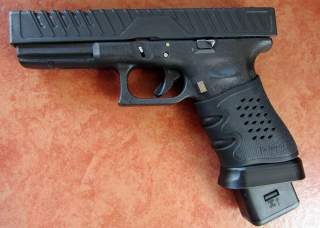This One Fight Made the Glock 22 a Favorite for America's Police
The best?
Although outnumbering the criminals four to one, the FBI agents found themselves facing superior firepower with inferior weapons.
One of Glock’s more controversial pistols, the Glock 22, was the direct result of lessons learned during an infamous gun battle.
(This first appeared in May 2019.)
The 1986 FBI Miami shootout, which saw a pair of criminals outgun a superior force of FBI agents, resulted in a revamping of firearms inventories and training across American law enforcement. One of the results was the new .40 Smith & Wesson round, which Glock quickly incorporated into a new semi-automatic pistol—the Glock 22.
In 1986, a gun battle erupted between federal agents and criminals Michael Platt and William Matix. The two were responsible for a spree of bank and armored car robberies in the south Florida region. Eight FBI agents, on the lookout for a car stolen by the pair, attempted to pull them over and a gunfight between the two sides ensued.
Although outnumbering the criminals four to one, the FBI agents found themselves facing superior firepower with inferior weapons. The FBI agents were armed with a single Remington 870 shotgun, and .38 Special, nine millimeter, and .357 magnum handguns. Platt and Matix were armed with a Ruger Mini-14 semi-automatic rifle and shotgun.
Over the course of four minutes, the two sides exchanged over 125 shots. Of the eight FBI agents, two were killed and another five wounded. Platt was shot twelve times and Matix six times before both were put down. As a result, the Federal Bureau of Investigation settled on a new round, .40 Smith & Wesson, which it believed would incapacitate targets more quickly than the smaller caliber .38 Special and nine-millimeter rounds.
The Glock 22 was the first .40 pistol to market, beating out Smith & Wesson. The Glock 22 was actually a Glock 17 adapted to shoot the new caliber ammunition. Although the Glock 17 was chambered in 9x17 millimeter, the .40 S&W round was technically 10x22 millimeter and was thus very similar in dimensions. The basic Glock pistol design could be easily adapted to handle the new round, allowing the Austrian gunmaker to get a leg up on the competition and sell tens of thousands of the new Glocks to local law enforcement agencies across America following the FBI’s lead to a heavier caliber.
The new pistol, named Glock 22, was very similar to the original Glock 17 handgun, a high capacity, striker-fired semi-automatic handgun. The Glock 22 had an overall length of 8.03 inches, a height of 5.47 inches, and a width of just 1.26 inches—dimensions identical to the Glock 17. Barrel length, 4.49 inches, was also identical.
The major difference sprung from the different calibers and was largely internal. The Glock 22, with its larger .40 S&W rounds, could carry just fifteen of the heavier, fatter rounds—two less than the nine-millimeter Glock 17. Although the rounds were larger there were fewer of them, resulting in a fully loaded net weight difference of only about an ounce. Within a few short years, the Glock 22 was the most popular police handgun in America.
Crimes with long guns, such as with a .223 Remington Mini-14 rifle in the case of the 1986 Miami shootout, are relatively rare. Long guns are difficult to conceal and, as a result, criminals generally prefer handguns. In 2016, out of 11,004 gun homicides, rifles and shotguns accounted for only 374 homicides.
In the ebb and flow of cartridge popularity, the .40 Smith & Wesson round is now losing ground against new nine-millimeter ammunitions that feature competitive levels of energy and velocity. Although the .40 S&W round’s future is now uncertain, the Glock 22 is still available for those that desire the larger pistol round’s performance. And if worst comes to worst, a Glock 22 can be converted to fire nine-millimeter ammunition. Furthermore, Glock’s .40 S&W handgun allows gun owners to shoot a variety of handgun ammunition without sacrificing performance.
Kyle Mizokami is a writer based in San Francisco who has appeared in The Diplomat, Foreign Policy, War is Boring and The Daily Beast. In 2009 he co-founded the defense and security blog Japan Security Watch. You can follow him on Twitter: @KyleMizokami.
Image: Wikimedia.

